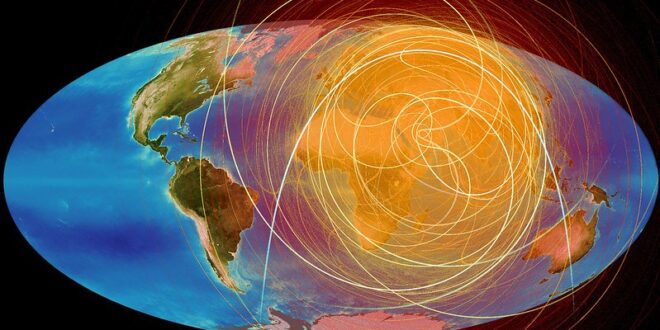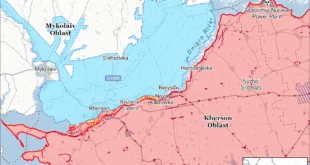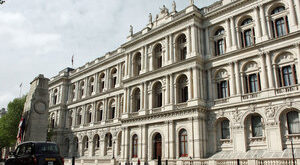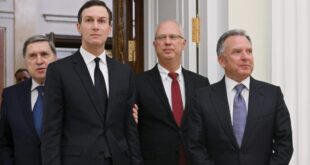The war in Ukraine poses numerous questions: What will be the country’s fate?; what will happen to the Ukrainian people?; will Russia be held accountable?; and what is the U.S.’s role in the war? One question that often goes unasked is: what does the war say about the nature of the international world order?
The Committee for Isolation Moderation offers the following definitions often used to describe the different structures of world order:
Unipolarity – a system in where a single nation holds dominance over much of the world.
Bipolarity – an international system where two nations hold dominance over much of the world.
Multipolarity – a system in which more than two nations hold power over the world or regions; multiple superpowers ….The Committee acknowledged, “the Cold War era between the end of World War II and the falls of the Berlin Wall [1989] and Soviet Union [1991] was bipolar in nature and resulted in relentless competition between the United States and the Soviet Union, with much of the rest of world forced to choose a side or being caught up in proxy wars between the two sole superpowers.”
In 1991, Charles Krauthammer, writing a piece in Foreign Affairs entitled “The Unipolar Moment,” insisted, “The immediate post-Cold War world is not multipolar. It is unipolar. The center of the world is the unchallenged superpower, the United States, attended by its Western allies.”
He clarifies, adding: “The unipolar moment means that with the close of the [20th] century’s three great civil wars (World War I, World War II and the Cold War) and ideologically pacified North seeks security and order to align its foreign policy behind that of the United State.” A few sentences later, he added: “The most striking feature of the post-Cold War world is its unipolarity. No doubt, multipolarity will come in time.”
NATO Expansion
The Intercept reported that, in 1997, 50 foreign policy leaders wrote to Pres. Bill Clinton that pushing NATO’s borders eastward would be “a policy error of historic proportions. We believe that NATO expansion will decrease allied security and unsettle European stability …” It added:
In Russia, NATO expansion, which continues to be opposed across the entire political spectrum, will strengthen the nondemocratic opposition, undercut those who favor reform and cooperation with the West, bring the Russians to question the entire post-Cold War settlement, and galvanize resistance in the Duma …”
By 1999, the new U.S.-dominant world order began to fray.
The conservative Hoover Institute noted that French President Jacques Chirac “condemned the U.S. Senate’s decision not to ratify the Comprehensive Test Ban Treaty, setting forth a vision of a multipolar world the chief organizing principle of which was the containment of American power.”
Going further, it pointed out, “For Chirac and other French officials, American unilateralism was a product of the post-Cold War imbalance of power and the emergence of the United States as the world’s lone ‘hyperpower.’”
It then adds, “Multilateralism was to be both the ultimate objective of a French-led effort to restore a balance and the means by which to achieve it.”
Many believe that the current Ukrainian war “is the most dangerous international conflict since the 1962 Cuban missile crisis.” But does it signify something more fundamental, a shift in the world order? Does it, as John Mearsheimer argues, represent a “change in the balance of power has created a situation where we’re moving away from unipolarity and toward multipolarity.”
Ukrainian Wars
In 2006, Mearsheimer, a University of Chicago professor, along with Harvard’s Stephen Walt, gained notoriety with their article, “The Israel Lobby and U.S. Foreign Policy,” published in London Review of Books.
However, his critical assessment of the U.S.’s role in both the Ukraine war of 2014 and today has generated considerable controversy. Michael Welton, writing in CounterPunch, quoted Mearsheimer: “The United States and its European allies are mainly responsible for the [2014] crisis. The taproot of the trouble is NATO expansion, the central element in a larger strategy to move all of Eastern Europe, including Ukraine, out of Russia’s orbit and integrate it into the West.” (Mearsheimer made a video presentation of his argument.)
Walton added, “Putin, Mearsheimer maintained, ‘that admitting those two countries would represent a ‘direct threat’ to Russia. If anybody had any doubts about Russia’s seriousness regarding accepting Georgia and Ukraine into NATO, the Russia-Georgia war in August 2008 should have dispelled those deluded thoughts.’”
In a recent interview in the New Yorker with Isaac Chotiner, Mearsheimer reiterated his analysis. “I think all the trouble in this case [the current war] really started in April, 2008, at the nato Summit in Bucharest, where afterward nato issued a statement that said Ukraine and Georgia would become part of nato,” he said. “The Russians made it unequivocally clear at the time that they viewed this as an existential threat, and they drew a line in the sand.”
Going further, Mearsheimer added: “Of course, this includes more than just nato expansion. nato expansion is the heart of the strategy, but it includes E.U. expansion as well, and it includes turning Ukraine into a pro-American liberal democracy, and, from a Russian perspective, this is an existential threat.”
Turning to the current Ukrainian war, Mearsheimer stated: “My argument is that the West, especially the United States, is principally responsible for this disaster.” He insisted:
It’s very important to understand that we [U.S.] nvented this story that Putin is highly aggressive and he’s principally responsible for this crisis in Ukraine. The argument that the foreign-policy establishment in the United States, and in the West more generally, has invented revolves around the claim that he is interested in creating a greater Russia or a reincarnation of the former Soviet Union.He reminded readers, “You realize that this is a country that has a G.N.P. that’s smaller than Texas.”
Mearsheimer’s critique of the U.S.’s role in the current Ukrainian war has provoked a good deal of debate. Two recent video engagements are illustrative. The Munk debate has him and Stephen Walt debating Michael McFaul and Radosław Sikorski. In a second one, he engages ex-C.I.A. Russia specialist Ray McGovern.
The argument was joined by Anne Applebaum, the neoliberal writer at The Atlantic, who tweeted: “Now wondering if the Russians didn’t actually get their narrative from Mearshimer et al. Moscow needed to say West was responsible for Russian invasions (Chechnya, Georgia, Syria, Ukraine), and not their own greed and imperialism. American academics provided the narrative.”
Adam Tooze, writing in The New Statesman, noted, “Appelbaum’s denunciation attracted a flurry of support, and students at the University of Chicago launched a menacing open letter demanding to know whether Mearsheimer was on the Russian payroll.”
Tooze then argued, “The scandal entails Mearsheimer’s refusal to see Putin’s aggression as anything other than the behaviour of a great power at bay.” And added, “What he is doing is simply elucidating the implications of his favourite IR [international relations] theory, known as “offensive” or “great power” realism. Russia is a great power.” Clarifying his analysis, he added:
Great powers, the theory goes, guard their security through spheres of interest. The US does so too, in the form of the Monroe doctrine and more recently in the Carter doctrine, which extends America’s interests to the Persian Gulf. If necessary, those zones are defended with force, and anyone who fails to recognise and respect this fails to grasp the violent logic of international relations.New World Order
Mearsheimer critique of the Russian-Ukrainian wars of 2014 and 2022 point to a deeper critique, one involving the changing international world order. As he wrote in 2019:
There are different kinds of international orders, and which type emerges depends primarily on the global distribution of power. But when the system is unipolar, the political ideology of the sole pole also matters. Liberal international orders can arise only in unipolar systems where the leading state is a liberal democracy.He then points out, “The Cold War order, which is sometimes mistakenly referred to as a ‘liberal international order,’ was neither liberal nor international. It was a bounded order that was limited mainly to the West and was realist in all its key dimensions.” Provocatively, he adds: “The U.S.-led post–Cold War order, on the other hand, is liberal and international, and thus differs in fundamental ways from the bounded order the United States dominated during the Cold War.”
The Berlin Wall fell in 1989 and the Soviet Union collapsed in 1991. In theory, the last three decades have been defined by the post-Cold War, “U.S-led” “unipolar” world order. It has significant influence on the World Trade Organization as well as the International Monetary Fund (IMF) and the World Bank. To “lead” the unipolar order, the U.S.’s estimated fiscal year 2023 military spending is $813 billion, and it maintains “roughly 750 US foreign military bases; they are spread across 80 nations!”
For Mearsheimer, a unipolar nation has power, suggesting that the Monroe Doctrine is alive-and-well. “We do have that say, and, in fact, we [the U.S.] overthrew democratically elected leaders in the Western hemisphere during the Cold War because we were unhappy with their policies. This is the way great powers behave.”
But, as the recent political debacle of the Pres. Biden’s “Summit of the Americans” reveals, U.S. political power over the continent is being undercut. First, exercising his muscle, Biden prohibited “non-democracy” countries to attend (i.e., Cuba, Nicaragua and Venezuela). In response, four “American” country — Mexico, El Salvador, Honduras and Guatemala – boycotted the event.
Perhaps more significant long-term, China has gained a strong foothold in Latin America and the Caribbean (LAC). According to one estimate, between 2000 and 2020 the China-LAC trade grew 26-fold from $12 billion to $315 billion.
Two-decades earlier, around the time of the Soviet Union’s collapse and the emergence of the unipolar world order, the BRIC countries – Brazil, Russia, India and China – emerged as a global-shifting force; in 2010, South Africa joined the emerging global force creating BRICS. A global realignment was beginning to take shape.
Expressions of this realignment is evident in the complex relations the post-Cold War Russia has with Europe. According to one source, European Union is Russia’s fifth largest export destination, led by China, the US, UK and Switzerland. Up till the current Ukrainian, it supplied 30 percent of Europe oil and 40 percent of its natural gas. However, “Russia’s GDP per capita is $11,584. Its standard of living is better than Brazil and Turkey, but worse than Greece, Hungary, or Poland.”
Mearsheimer warns, “A liberal international order is possible only in unipolarity.” And for the U.S., for all its military bases and spending as well as influence over the global economy, the unipolar world order is shaking, if not breaking up. He adds: “The new multipolar world will feature three realist orders: a thin international order that facilitates cooperation, and two bounded orders—one dominated by China, the other by the United States—poised for waging security competition between them.”
More troubling, Mearsheimer warns: “Liberal international orders can arise only in unipolar systems where the leading state is a liberal democracy.” What happens to “liberal democracy” in a multipolar world”?
Let’s assume that the unipolar world order has given way, and a multipolar world order is emerging. It well might be a new, 21st century of version of the old, 20th century Cold War, but this time with a primary rivalry between the U.S. and China. But it might stronger geo-political clusters (that would be armed) in Europe, Latin America, Middle East and southern Africa.
For Americans, signs of the new multipolar order might be emerging. One might well be the current political realignment signified by the rise of Donald Trump, a more nationalistic, anti-abortion and anti-lgbt conservatism, and the emergence of a militant, violent rightwing.
Another might be the growing inequality. Inequality.org reports: “Over 20 percent of our nation’s income flows to the top 1 percent. The top 1 percent’s share of our country’s wealth is approaching 40 percent. Our top 0.1 percent hold roughly the same share of our wealth as our bottom 90 percent.” Only time will tell.
 Eurasia Press & News
Eurasia Press & News




